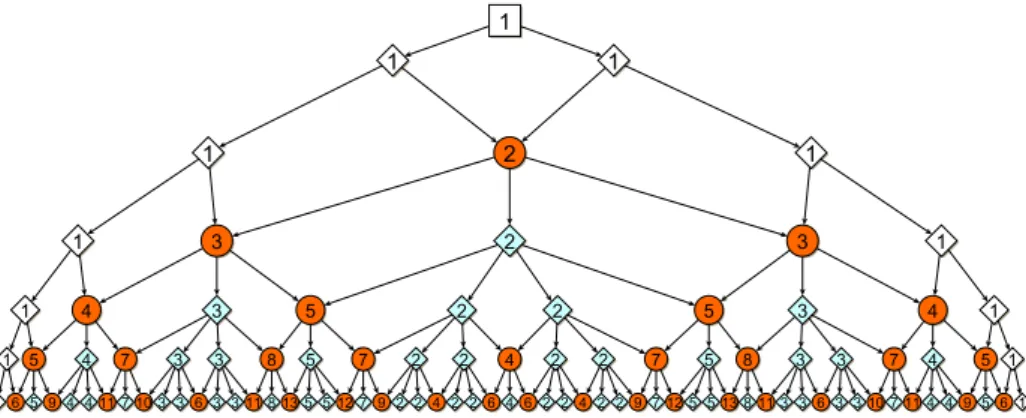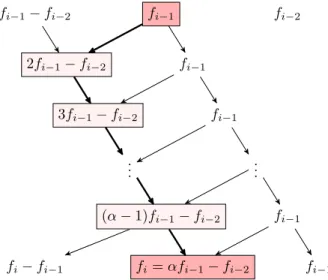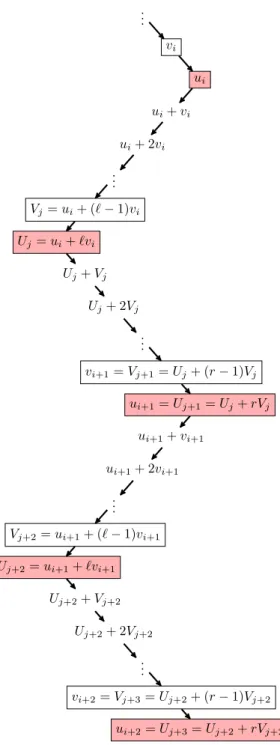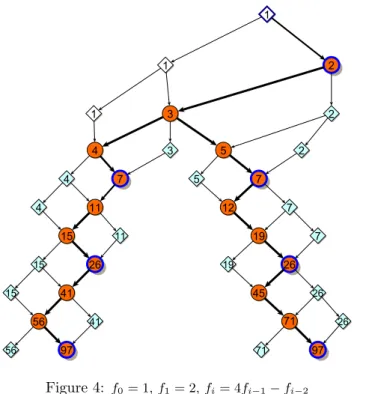Recurrence sequences in the hyperbolic Pascal triangle corresponding to the regular
mosaic { 4, 5 }
László Németh
a, László Szalay
acaInstitute of Mathematics University of West Hungary, Sopron nemeth.laszlo@nyme.hu,szalay.laszlo@nyme.hu
cDepartment of Mathematics and Informatics J. Selye University, Komarno, Slovakia
Submitted April 17, 2016 — Accepted September 5, 2016
Abstract
Recently, a new generalization of Pascal’s triangle, the so-called hyper- bolic Pascal triangles were introduced. The mathematical background goes back to the regular mosaics in the hyperbolic plane. In this article, we investi- gate the paths in the hyperbolic Pascal triangle corresponding to the regular mosaic{4,5}, in which the binary recursive sequencesfn=αfn−1±fn−2are represented (α∈N+).
Keywords:Pascal triangle, hyperbolic Pascal triangle, binary recurrences.
MSC:11B37, 05A10.
1. Introduction
In the hyperbolic plane there are an infinite number of types of regular mosaics (see, for example [4]), they are assigned by Schläfli’s symbol {p, q}, where the positive integers p and q satisfy (p−2)(q−2) > 4. Each regular mosaic induces a so- called hyperbolic Pascal triangle (see [1]), following and generalizing the connection between the classical Pascal’s triangle and the Euclidean regular square mosaic {4,4}. For more details see [1], but here we also collect some necessary information.
http://ami.ektf.hu
165
There are several approaches to generalize Pascal’s arithmetic triangle (see, for instance [3]). The hyperbolic Pascal triangle based on the mosaic {p, q} can be figured as a digraph, where the vertices and the edges are the vertices and the edges of a well defined part of the lattice {p, q}, respectively, further each vertex possesses a value, say label, giving the number of different shortest paths from the fixed base vertex. Figure 1 illustrates the hyperbolic Pascal triangle linked to {p, q} ={4,5}. Generally, for {4, q}, the quadrilateral shape cells surrounded by appropriate edges are corresponding to the squares in the mosaic. The base vertex has two edges (both are outgoing), the leftmost and the rightmost vertices have three (one ingoing and two outgoing), the others have qedges (either two ingoing andq−2outgoing (typeA) or one ingoing andq−1outgoing (typeB)). In other words, apart from the winger elements, vertices of type A have two ascendants andq−2descendants, vertices of typeB do one ascendant andq−1 descendants.
In the figures, we denote theA-type vertices by red circle andB-type vertices by cyan diamond, further the wingers by white diamond. The vertices having distance n from the base vertex are located in row n. The general method of drawing is the following. Going along the vertices of the nth row, according to type of the elements (winger,A,B), we draw appropriate number of edges downward (2,q−2, q−1, respectively). Neighbor edges of two neighbor vertices of thenthrow meet in the(n+ 1)th row, constructing a vertex of typeA. The other descendants of row nin rown+ 1have typeB, except the two wingers. In the sequel,
)
nk(
denotes the kth element in rown, which is either the sum of the labels of its two ascendants or coincide the label of its unique ascendant. For instance, if{p, q}={4,5}, then)
46(
= 5 = 2 + 3 =)
32(
+)
33(
and)
45(
= 2 =)
32(
hold (see Figure 1). We note, that the hyperbolic Pascal triangle has the property of vertical symmetry.
Figure 1: Hyperbolic Pascal triangle linked to{4,5}up to row 6
2. Recurrence sequences linked to { 4, 5 }
Let {p, q} ={4,5} be fixed, further we let HPT45 denote the hyperbolic Pascal triangle corresponding to the mosaic{4,5}. It was showed in [1] that all the binary recurrence sequences (fi)i≥0 which are defined by
fi=ηfi−1+fi−2, (n≥2), (2.1) whereη and f0< f1 are positive integers, appear inHPT45.
In the following we describe paths corresponding to further positive integer binary recurrence sequences. We remark that although we restrict ourselves to HPT45, the methods and the results have been worked out can be fitted to other hyperbolic Pascal triangles with p= 4, q≥6.
Taking a vertex of typeA in rown, it has exactly two descendants of typeA in the rown+ 1. In order to reach and distinguish them, we denote the left-down step and right-down step (along the appropriate edge of the graph) by L and R, respectively. For the sake of brevity, the sequence of`+rconsecutive steps
LL· · ·L
| {z }
`
RR· · ·R
| {z }
r
will be denoted byL`Rr. Till the end of this work, such a path is always considered on vertices of type A. Generally, we are interested in the labels of these vertices, therefore sometimes we call them elements (as the elements or terms of a sequence), but if it is necessary we determine the location of the element, too.
This paper will use the next theorem (Theorem 5 in [1]), which states that any two positive integers can be found next to each other somewhere inHPT45. Theorem 2.1. Given u, v∈N+, then there exist n, k∈N+ such that u=
)
nk(
and v=)
k+1n(
.Using Theorem 2.1, Corollary 2.2 provides an immediate consequence of the properties of HPT45.
Corollary 2.2. If u =
)
nk(
< v =)
k+1n(
holds for some positive integers uand v, then)
k+2n(
=v−u, moreover the type of)
k+1n(
isA, while the types of)
nk(
and)
k+2n(
are not A (i.e., eitherB or winger).
Remark 2.3. Clearly, by the symmetry we also have the constructionu=
)
nk(
> v=)
k+1n(
and)
k−1n(
=u−v. Further, the type of)
nk(
is A.2.1. Recurrence sequences and paths
Let(fi)i≥0be a recurrence sequence defined by
fi=αfi−1−fi−2, (i≥2), (2.2)
where α∈ N+, α≥2, and f0 < f1 are positive integers with gcd(f0, f1) = 1. If α= 2then(fi)i≥0 is an arithmetic progression given byfi=fi−1+ (f1−f0).
From Theorem 2.1 and Corollary 2.2 we know that in case of any positive integersf0< f1, there exist an element inHPT45with valuef1, and with neighbors in the same row valued byf0andf1−f0. In Theorem 2.4 we give a path inHPT45 (analogously to Theorem 6 in [1]) contains all the elements of (2.2).
Theorem 2.4. There exists a path inHPT45 crossing vertices of typeA, such that the vertices are labelled with the terms of(fi)i≥1 as follows. Assume that
)
nk(
=f1, and)
k−1n(
=f1−f0. Then the first element of the path is f1 and the pattern of the steps from fi−1 tofi (i≥2) isLRα−2.Proof. According to Theorem 2.1, anyf1andf1−f0can be neighbours inHPT45, where type off1 isA(and the type of f1−f0 is notA).
If α = 2, then the statment is easy to show, since no R steps. Indeed, the difference of an element typeA, and its immediate left descendant having typeA is the constantf1−f0.
Assume nowα≥3. By the construction rule ofHPT45, we can follow the way from any fi−1 to fi (i ≥2) in Figure 2, which justifies the theorem (the type of the rectangle shaped elements is A). In the last row of the figure we use, among others, the equalityfi−fi−1= (α−1)fi−1−fi−2.
fi−1−fi−2
2fi−1−fi−2
3fi−1−fi−2
...
(α−1)fi−1−fi−2
fi=αfi−1−fi−2
fi−1
fi−1
fi−1
...
fi−1
fi−1
fi−fi−1
fi−2
Figure 2: PathLRα−2 betweenfi−1 andfi
Remark 2.5. Theorem 2.4 can be extended for the whole sequence(fi)i≥0 if and only if(α−1)f0< f1< αf0. Under these conditions one can follow the path back from the bottom of Figure 2 to the top, fromf1 tof0.
The path showed on the right hand side of Figure 4 (cf. Figure 1) is an example for the binary recurrencefi= 4fi−1−fi−2 withf0= 1,f1= 2.
Theorem 2.4 finds a path to the sequence (2.2). Considering the opposite di- rection, now we decribe the sequence corresponding to a given pattern of steps.
The expression “corner element” means a labelled vertex where the direction of the sequence of steps changes. For example, the first corner element of the path L3R2 is the vertex reached after three left steps, the second corner element comes after further two right steps, etc.
Theorem 2.6. Suppose that the A-type vertex
)
nk(
=U1 =u1 is a starting point of the path L`Rr. We let Ui, and ui (i = 1, . . .) denote the label of the corner elements, and the label of every second corner elements of the path, respectively.Then we have
ui= (`r+ 2)ui−1−ui−2, (i≥3). (2.3) Moreover, if`=r, then
Ui=`Ui−1+Ui−2, (i≥3).
Obviously, ui =U2i−1 holds. The proof of Theorem 2.6 applies the following lemma (see [1], Remark 1 linked to Lemma 4).
Lemma 2.7. Letx0,y0, furtheraj andbj (j= 1,2) be complex numbers such that a2b16= 0. Assume that for i≥i0 the terms of the sequences(xi)and(yi)satisfy
xi+1=a1xi+b1yi, yi+1=a2xi+b2yi. Then for both sequences
zi+2= (a1+b2)zi+1+ (−a1b2+a2b1)zi
holds (i≥i0).
Proof of Theorem 2.6. Suppose that v1 is the left ascendant of u1. By Figure 3, which demonstrates the path precisely from ui to ui+2 (i≥1) along vertices type Ain HPT45, we gain the system of the recursive equations
ui+1= (r+ 1)ui+ (`+r(`−1))vi, (2.4) vi+1=rui+ (`+ (r−1)(`−1))vi.
Using Lemma 2.7 we receive that bothui andvi satisfy the equation zi+2= (`r+ 2)zi+1−zi.
If`=r, then we simply obtain
Ui+1=Ui+`Vi, (2.5)
Vi+1=Ui+ (`−1)Vi. Now Lemma 2.7 results thatUi andVi satisfy the equation
Zi+2=`Zi+1+Zi.
...
vi
ui
ui+vi
ui+ 2vi
...
Vj=ui+ (`−1)vi
Uj=ui+`vi
Uj+Vj
Uj+ 2Vj
...
vi+1=Vj+1=Uj+ (r−1)Vj ui+1=Uj+1=Uj+rVj
ui+1+vi+1
ui+1+ 2vi+1
...
Vj+2=ui+1+ (`−1)vi+1
Uj+2=ui+1+`vi+1 Uj+2+Vj+2
Uj+2+ 2Vj+2
...
vi+2=Vj+3=Uj+2+ (r−1)Vj+2
ui+2=Uj+3=Uj+2+rVj+2
Figure 3: PathL`Rr fromuitoui+2
Remark 2.8. Let
)
nk(
=f1be the initial element, and consider the pathL`Rr. Since every second corner element of the path satisfies the recurrence equation (2.2) with α = `r+ 2, the number of different paths belonging to different patterns but corresponding to the linear recurrence(fi)∞i=1 is the number of the divisors of`r=α−2.
Figure 4 gives an example for the case when α−2 = 2 = 2·1 = 1·2 and u1=f1= 2,u2=f2= 7. Clearly, the patters areL2RandLR2.
Figure 4: f0= 1,f1= 2,fi= 4fi−1−fi−2
Now we describe the intermediate sequences located in the path given by v1,
)
nk(
= u1 and by L`Rr. The labels of the elements having distance (`+r)t (t∈N)from the base element)
nk(
are given by suitable sequences {wi}.Theorem 2.9. Put wi =ui+mvi, where 0≤m < `, or let wi =U2i+mV2i = (m+ 1)ui+ (`+m(`−1))vi, where 0≤m < r. Then the terms of the sequence (wi)satisfy
wi= (`r+ 2)wi−1−wi−2, (i≥3).
Proof. Consider again Figure 3 to show the statement for the first type of sequences.
One can observe the labels of the path described bywi=ui+mvi, where0≤m < ` andi≥1. From (2.3) we see
wi+2=ui+2+mvi+2= (`r+ 2)(ui+1+kvi+1)−(ui+mvi)
= (`r+ 2)wi+1−wi.
The second part of the proof is analoguous. In Figure 3 the equationj= 2iholds, but generally it does not.
Corollary 2.10. In case of`=r,Wj=Uj+mVj (0≤m < `)satisfy the equation Wj =`Wj−1+Wj−2, (j≥3). (2.6) In Figure 5, according to Corollary 2.10 we give two examples for the represen- tation of elements of recurrence sequence fi = 3fi−1+fi−2. The pattern of both paths is R3L3, moreover, u1 = 3, v1 = 2, m = 2 and u1 = 4, v1 = 3, m = 1, respectively.
Figure 5: f0= 1,f1= 2,fi= 3fi−1+fi−2
Theorem 2.11. Consider the sequence (2.2). If`r=α−2, and
m=fj+1−(r+ 1)fj
`+r(`−1)
is an integer for some j ≥1, furtherm < fj holds, then the elements fi (i ≥j) can be represented in HPT45 by every second corner elements of a paths given by the the patternL`Rr, and by u1=fj andv1=m.
Proof. Letu1 =fj andu2 =fj+1. Then equation (2.4) yields v1 = (fj+1−(r+ 1)fj)/(`+r(`−1)). Since the integersv1 andu1are neigbours in a suitable row of HPT45, therefore there is a path with the patternL`Rr fromv1 andu1such that every second corner elements arefi+1 (i≥j).
Figure 4 gives examples on the paths offi= 4fi−1−fi−2 with initial elements u1 =f2 = 7 and u2 =f3 = 26, moreover v1 = 4 andv1 = 5, respectively, where α−2 = 2 = 2·1 = 1·2 =lr, and the patters areL2Rand LR2.
Theorem 2.12. Consider now the sequence (2.1). If`2=η−2, andm= (fj+1− fj)/` is an integer, further m < fj, then the elements fi (i ≥ j ≥ 1) can be represented in HPT45 by every corner elements of the paths given by the pattern L`Rr, and by u1=fj andv1=m.
Proof. The proof is similar to the proof of Theorem 2.11. Using (2.5), fromu1=fj
andu2=fj+1 we gain v1= (fj+1−fj)/`.
References
[1] H. Belbachir, L. Németh, L. Szalay, Hyperbolic Pascal triangles, Appl. Math.
Comp.,273(2016), 453–464.
[2] L. Németh, L. Szalay, Alternating sums in hyperbolic Pascal triangles, Miskolc Mathematical Notes, (accepted).
[3] H. Belbachir, L. Szalay, On the arithmetic triangles, ˘Siauliai Math. Sem.,9(17) (2014), 15–26.
[4] H. S. M. Coxeter, Regular honeycombs in hyperbolic space, inProc. Int. Congress Math., Amsterdam, Vol. III., 1954, pp. 155–169.



